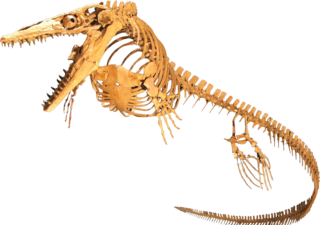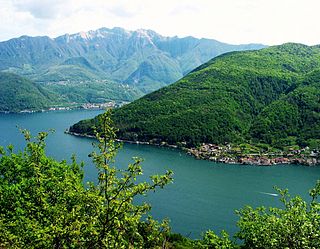
The Cambrian is the first geological period of the Paleozoic Era, and the Phanerozoic Eon. The Cambrian lasted 51.95 million years from the end of the preceding Ediacaran period 538.8 Ma to the beginning of the Ordovician Period 486.85 Ma.

Trilobites are extinct marine arthropods that form the class Trilobita. Trilobites form one of the earliest known groups of arthropods. The first appearance of trilobites in the fossil record defines the base of the Atdabanian stage of the Early Cambrian period and they flourished throughout the lower Paleozoic before slipping into a long decline, when, during the Devonian, all trilobite orders except the Proetida died out. The last trilobites disappeared in the mass extinction at the end of the Permian about 251.9 million years ago. Trilobites were among the most successful of all early animals, existing in oceans for almost 270 million years, with over 22,000 species having been described.

Gastropods, commonly known as slugs and snails, belong to a large taxonomic class of invertebrates within the phylum Mollusca called Gastropoda.

Mosasaurs are an extinct group of large aquatic reptiles within the family Mosasauridae that lived during the Late Cretaceous. Their first fossil remains were discovered in a limestone quarry at Maastricht on the Meuse in 1764. They belong to the order Squamata, which includes lizards and snakes.

Goniatids, informally goniatites, are ammonoid cephalopods that form the order Goniatitida, derived from the more primitive Agoniatitida during the Middle Devonian some 390 million years ago. Goniatites (goniatitids) survived the Late Devonian extinction to flourish during the Carboniferous and Permian only to become extinct at the end of the Permian some 139 million years later.

A microfossil is a fossil that is generally between 0.001 mm and 1 mm in size, the visual study of which requires the use of light or electron microscopy. A fossil which can be studied with the naked eye or low-powered magnification, such as a hand lens, is referred to as a macrofossil.
In the geological timescale, the Tithonian is the latest age of the Late Jurassic Epoch and the uppermost stage of the Upper Jurassic Series. It spans the time between 149.2 ±0.7 Ma and 143.1 ±0.6. It is preceded by the Kimmeridgian and followed by the Berriasian.

An interglacial period is a geological interval of warmer global average temperature lasting thousands of years that separates consecutive glacial periods within an ice age. The current Holocene interglacial began at the end of the Pleistocene, about 11,700 years ago.

Monte San Giorgio is a Swiss mountain and UNESCO World Heritage Site near the border between Switzerland and Italy. It is part of the Lugano Prealps, overlooking Lake Lugano in the Swiss Canton of Ticino.
Kuanyangia is an extinct genus from a well-known class of fossil marine arthropods, the trilobites. It lived during the early part of the Botomian stage, which lasted from approximately 524 to 518.5 million years ago. This faunal stage was part of the Cambrian Period.
Arthricocephalus is an extinct genus from a well-known class of fossil marine arthropods, the trilobites. It lived during the later part of the Botomian stage, which lasted from approximately 524 to 518.5 million years ago. This faunal stage was part of the Cambrian Period.
Megapalaeolenus is an extinct genus from a well-known class of fossil marine arthropods, the trilobites. They lived during the later part of the Botomian stage, which lasted from approximately 524 to 518.5 million years ago. This faunal stage was part of the Cambrian Period.
Megalaspidella is an extinct genus from a well-known class of fossil marine arthropods, the trilobites. It lived during the later part of the Arenig stage of the Ordovician Period, approximately 478 to 471 million years ago.

Megalaspides is an extinct genus from a well-known class of fossil marine arthropods, the trilobites. It lived during the later part of the Arenig stage of the Ordovician Period, approximately 478 to 471 million years ago.

The Bontnewydd palaeolithic site, also known in its unmutated form as Pontnewydd, is an archaeological site near St Asaph, Denbighshire, Wales. It is one of only three sites in Britain to have produced fossils of ancient species of humans and the only one with fossils of a classic Neanderthal. It is located a few yards east of the River Elwy, near the hamlet of Bontnewydd, near Cefn Meiriadog, Denbighshire.
The Sangamonian Stage is the term used in North America to designate the Last Interglacial and depending on definition, part of the early Last Glacial Period, corresponding to Marine Isotope Stage 5. While often historically considered equivalent in scope to MIS 5, it is now often used in a more narrow sense to refer to the Last Interglacial only. It preceded the Wisconsinan (Wisconsin) Stage and followed the Illinoian Stage in North America.
Nozamichthys is an extinct genus of ray-finned fish that lived during the late Moscovian stage of the Pennsylvanian epoch in what is now Illinois, United States. Fossils were collected from the Mazon Creek fossil beds. The first part of the genus name is Mazon spelled backwards, and the second part means 'fish'.

Tarpon are fish of the genus Megalops. They are the only members of the family Megalopidae. Of the two species, one is native to the Atlantic, and the other to the Indo-Pacific Oceans.

Crustaceans are invertebrate animals that constitute one group of arthropods that are a part of the subphylum Crustacea, a large, diverse group of mainly aquatic arthropods including decapods, seed shrimp, branchiopods, fish lice, krill, remipedes, isopods, barnacles, copepods, opossum shrimps, amphipods and mantis shrimp. The crustacean group can be treated as a subphylum under the clade Mandibulata. It is now well accepted that the hexapods emerged deep in the Crustacean group, with the completed pan-group referred to as Pancrustacea. The three classes Cephalocarida, Branchiopoda and Remipedia are more closely related to the hexapods than they are to any of the other crustaceans.

Yamatosaurus is a genus of basal hadrosaurid from the Late Cretaceous (Maastrichtian)-aged Kita-Ama Formation of Awaji Island, Japan. The genus contains a single species, Yamatosaurus izanagii.












